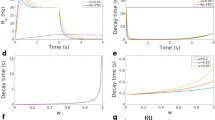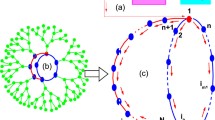Abstract
Stevens’ law, which is one of the well-known psychophysical laws, suggests that the perceived intensity R of a biological system is proportional to the power of the stimulus strength I, R ∝ I n. In order to realize a self-sustainable system that adapts to changes of the environment, it is important to understand the neural mechanism behind this law. Here, we propose a new neural scheme based on the shunting short-term memory (STM) model with the physiological properties of the nervous system, and examine the relation between the neural system and Stevens’ law through computer simulations of the firing rate f with respect to the stimulus strength I. The simulations showed that the feedback-inputting connectivity plays an important role in reproducing the n > 1 and n < 1 cases of Stevens’ law.
Similar content being viewed by others
References
Stevens SS (1975) Psychophysics. Wiley
Pluvinage V, Green DG (1990) Evidence for a power law intensity code in the coupled cones of the turtle. Vision Res 30: 673–682
Yasui S (1992) On the square root intensity coding at the level of cone photoreceptors. Vision Res 32: 199–202
Copelli M, Kinouchi O (2005) Intensity coding in two-dimensional excitable neural networks. Physica 349: 431–442
Tal D, Schwartz E (1997) Computing with the leaky integrate-and-fire neuron: logarithmic computation and multiplication. Neural Comput 9: 305–318
Grossberg S (1988) Nonlinear neural networks: principles, mechanisms and architectures. Neural Networks 1: 17–61
Harvey RL (1994) Neural network principles. Prentice–Hall
Hodgkin AL, Huxley AF (1952) A quantitative description of membrane current and its application to conduction and excitation in nerve. J Physiol 117: 500–544
Gerstner W, Kistler W (2002) Spiking neuron models. Cambridge University Press
Purves D et al (2001) Neuroscience, 2nd edn. Sinauer Associates
Author information
Authors and Affiliations
Corresponding author
Rights and permissions
About this article
Cite this article
Yamanishi, T., Nosaka, M., Nishimura, H. et al. Neural Model Approach to the Basic Law of Psychophysics. Neural Process Lett 27, 115–123 (2008). https://doi.org/10.1007/s11063-007-9063-8
Received:
Accepted:
Published:
Issue Date:
DOI: https://doi.org/10.1007/s11063-007-9063-8




